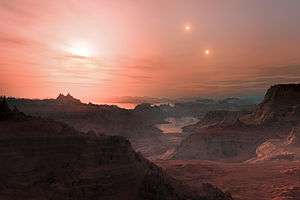2012 LZ1
| Discovery[1] | |
|---|---|
| Discovered by | Robert H. McNaught |
| Discovery site | Siding Spring Survey |
| Discovery date | 10 June 2012 |
| Designations | |
| MPC designation | 2012 LZ1 |
| Amor, NEO, PHA[2] | |
| Orbital characteristics[2] | |
| Epoch 13 January 2016 (JD 2457400.5) | |
| Uncertainty parameter 2 | |
| Aphelion | 4.0667 AU (608.37 Gm) (Q) |
| Perihelion | 1.0492 AU (156.96 Gm) (q) |
| 2.5579 AU (382.66 Gm) (a) | |
| Eccentricity | 0.58984 (e) |
| 4.09 yr (1494.3 d) | |
| 312.53° (M) | |
| 0° 14m 27.312s /day (n) | |
| Inclination | 26.102° (i) |
| 264.53° (Ω) | |
| 14.241° (ω) | |
| Earth MOID | 0.043164 AU (6.4572 Gm) |
| Jupiter MOID | 1.1348 AU (169.76 Gm) |
| Physical characteristics | |
| Dimensions | ~1 km[3] |
| 12.87 h (0.536 d) | |
Sidereal rotation period | 10 - 15 hr[3] |
| 0.02 - 0.04[3] | |
| 19.9[2] | |
|
| |
2012 LZ1 is an asteroid classified as near-Earth object and potentially hazardous asteroid of the Amor group, approximately 1 km (0.62 mi) in diameter.[4] It passed within 5.4 million kilometers (14 lunar distances) of Earth on June 14, 2012.[4] It was discovered during the night of June 10–11, 2012 by astronomer Robert H. McNaught and his colleagues using the 0.5-meter Uppsala Southern Schmidt Telescope at the Siding Spring Observatory in Australia, just four days before its closest approach to Earth.[5][6]
Overview
Arecibo radar observations on June 19, 2012 have shown that 2012 LZ1 is about 1 kilometre (0.62 mi) in diameter and that 2012 LZ1 has zero chance of impacting the Earth for at least the next 750 years.[3]
A small change of trajectory caused by Earth's gravity was predicted from the 2012 passby.[7] The Slooh Space Camera streamed live footage of the passby over the Internet.[6] McNaught and Astronomy magazine columnist Bob Berman hosted the broadcast.[5] "We love it when stuff like this happens, because it's fun to do and the public appreciates it," said Slooh president Patrick Paolucci.[7] The asteroid was the same brightness as a 13th-magnitude star, too faint to be seen by the naked eye or a low-end telescope.[5][7]
The next passby for 2012 LZ1 was July 27, 2016 at 0.5 AU (75,000,000 km; 46,000,000 mi) from Earth.[7][8]
See also
- 2005 YU55, a near-Earth asteroid roughly half the size.
- Near-Earth Asteroid Tracking
References
- ↑ "MPEC 2012-L30 : 2012 LZ1". IAU Minor Planet Center. 2012-06-12. Retrieved 2012-06-26. (K12L01Z)
- 1 2 3 "JPL Small-Body Database Browser: (2012 LZ1)" (2012-06-25 last obs). Jet Propulsion Laboratory. Retrieved 1 April 2016.
- 1 2 3 4 Stacy Bowles (21 June 2012). "Arecibo Observatory Finds Asteroid 2012 LZ1 To Be Twice As Big As First Believed". Universities Space Research Association. Archived from the original on 27 June 2012. Retrieved 21 June 2012.
- 1 2 "Humongous asteroid to hurtle past Earth Thursday". Christian Science Monitor. 2012-06-14. Retrieved 2012-06-14.
- 1 2 3 "Huge Asteroid to Fly by Earth Thursday: How to Watch Online". Space.com. Retrieved 2012-06-14.
- 1 2 Wall, Mike (2012-05-20). "Huge asteroid to fly by Earth Thursday - Technology & science - Space - Space.com - msnbc.com". MSNBC. Retrieved 2012-06-14.
- 1 2 3 4 Ker Than (2012-06-14). "Large Asteroid to Buzz Earth Tonight—Watch It Live". National Geographic. Retrieved 2012-06-14.
- ↑ "2012 LZ1 Ephemerides for July 2016". NEODyS (Near Earth Objects - Dynamic Site). Retrieved 2012-06-15.

